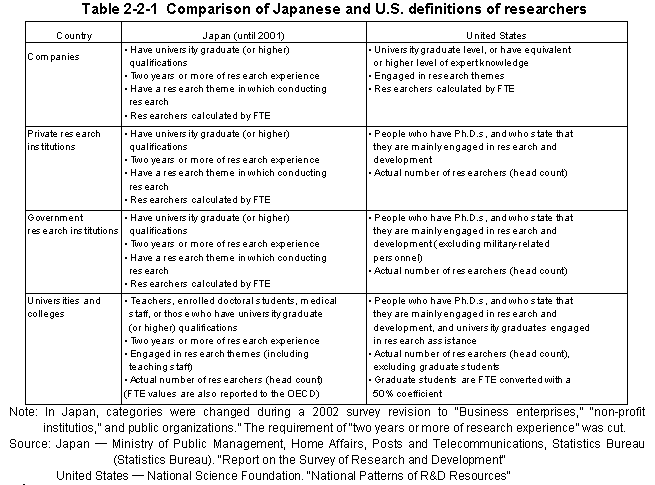| Home > Policy > White Paper, Notice, Announcement > White Paper > WHITE PAPER ON SCIENCE AND TECHNOLOGY2003 > Part2 2.2 2.2.1 2.2.1.1 | ||
Countries use different methods for determining the number of researchers.The Frascati Manual de-fines researchers as"professionals engaged in the conception or creation of new knowledge,pro-ducts processes,methods,and systems,and in the management of the projects concerned."But this definition is quite vague,and countries that follow the Frascati Manual also specify their own definitions of the term"researcher"for counting re-searchers.
For this reason,there are differences between countries in methods for measuring the number of researchers,and international comparisons are difficult.In comparison between Japan and the United States,the number of researchers counted in the Report on the Survey of Research&Development conducted by the Statistics Bureau of Japan's Ministry of Public Management,Home Affairs,Posts and Telecommunications is not exactly equivalent to the researchers counted in the U.S.National Science Foundation's National Patterns of R&D Resources.Differences of methods for determining the number of researchers are shown in Table2-2-1 ,and would appear to be obstructing a fair statistical comparison.The category of researcher at universities and colleges,in Japan,consisting of teachers,doctoral students,medical staff,etc.,differs between Japan and the United States in the following ways.
| (1)Teaching staff |
In1995,a year in which it's possible to compare teachers in Japan and the United States,160,634teachers at universities and colleges in Japan,including those in the humanities and social sciences,were classified as researchers,while in the United States only the89,300university and college teaching personnel who responded that they had obtained a doctoral degree and were primarily engaged in research were classified as researchers-a smaller result than in Japan.
It would appear,then,that the number of teaching personnel in the United States who are involved in research is much larger than in Japan when the same kind of statistics are used.On the other hand,if the same statistical method used as in the United States were applied to Japan,the number of Japanese researchers would be smaller.
| (2)Number of graduate school students |
A comparison for1999reveals that59,057people who were studying in doctoral courses,including the humanities and social sciences,in Japan were classified as researchers.This figure is virtually identical to the1999figure of59,007graduate school students in doctoral courses counted in the Ministry of Education,Culture,Sports,Science and Technology's"Handbook of Education,Culture,Sports,Science and Technology Statistics(2003edition)."
In the United States,however,the number of graduate school students receiving remuneration for research assistance work is91,308people(NSF,"Science and Engineering Indicators2002"),which is reduced by the FTE(full-time equivalent)rate coefficient of50%to arrive at a total of45,700researchers.In the United States,therefore,while the count extends beyond the doctoral courses to include people in Master's course programs as well,it is limited to students who are engaged in re-search assistance work,and is further reduced by a predetermined coefficient.Thus,it is highly probable that the estimate for number of researchers would yield a lower result than Japan's method of including all students engaged in doctoral course programs.
Therefore,when making comparisons between Japan and the United States,it is important to re-member that the measurement of researcher numbers in Japan is overestimated,primarily at the universities.In2002,the Ministry of Education,Culture,Sports,Science and Technology con-ducted a"Survey of Full-time Equivalency Data at Universities and Colleges,"the results of which will be used in the future to estimate the number of researchers.

As a result,while there may be differences in the methods of measuring researcher numbers,it is useful,however,to look at general trends for each country from its own methods.The United States had the largest number of researchers(1999:1,261,000),followed by Japan,at756,000(2002:676,000using FTE),and Germany(2000:259,000) (Figure2-2-2).
The total number of researchers in Japan de-creased by1.46%in FY2001 over the previous year(1.72%using FTE),and was followed by a year-on-year increase of0.75%in FY2002(4.37%using FTE).However,the2002survey included revised sections(expansion of surveyed industries,a changed survey date,and an altered definition of researchers,etc.).The annual average rates of increase since1982were4.36%(4.79%using FTE)in1982-1987,4.23%(4.56%using FTE)in1987-1992,3.05%(4.68%using FTE)in1992-1997,and0.97%(1.83%using FTE)in1997-2002.
| Back to Top | MEXT HOME |